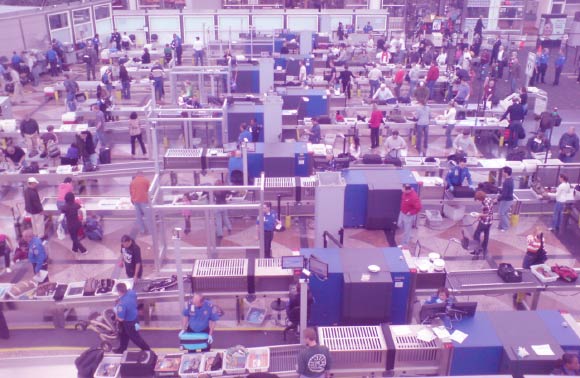A real-time, hand-held chemical scanner with stand-off detection capabilities has been unveiled by a team of researchers and engineers from nine European countries.

Security screening area. Image credit: Dan Paluska / CC0 1.0.
The device can scan from a distance of up to 100 feet (30 m) and is capable of instantaneous, real-time, unambiguous detection.
Harnessing new photonics technology, the device uses spectroscopic sensors that read the unique frequencies, or ‘signatures,’ given off when liquids or gasses interact with light.
With real-time scanning delivering a realistic detection rate of one every few seconds, and therefore a rate of 1,200 per hour, the new device can deliver over 6 times more capability than state-of-the-art trace portal scanners that detect bombs and illegal drugs at a rate of 180 of passengers per hour.
While the device has many other capabilities, such as the early detection of diseases, scanning for bacteria in fridges or even detecting the presence of alcohol from afar, its stand-off detection capabilities mean the small device could be installed on the front of airports, scanning crowds in real-time for suspicious material before they even entered the building.
The device was created by the MIRPHAB (Mid-InfraRed PHotonics devices fABrication for chemical sensing and spectroscopic applications) consortium.
“We are making the next generation of sensors that are compact, low cost and low on power consumption and capable real-time detection where the speed and sensibility is unrivaled,” said MIRPHAB coordinator Sergio Nicoletti, from CEA-Leti, France.
“We want to shrink current technology down to the size of a mobile phone.”
“Spectroscopic sensing in the Mid-IR wavelength band (3 to 12 μm) is a powerful analytical tool to address societal challenges like climate change or monitoring emission controls,” said Jose Pozo, Director of Technology and Innovation at the European Photonics Industry Consortium (EPIC).
“In this wavelength band, the so-called ‘fingerprint region,’ chemicals exhibit intense adsorption features allowing superior detection capabilities and unambiguous identification.”
“With links already established in sectors such as health, automotive, medical and domestic, MIRPPHAB will turn these achievements into business and commercial opportunities for both SMEs (Small and medium-sized enterprises) and large industrial groups,” he added.
“Within MIRPHAB, we have set the ambitious goal of creating a commercially viable pilot line for the fabrication of Mid-IR sensors that is ready for business by 2020.”
“This result will be achieved by setting up and operating a fabrication platform, offering open access for fast Mid-IR device prototyping to European industry.”







